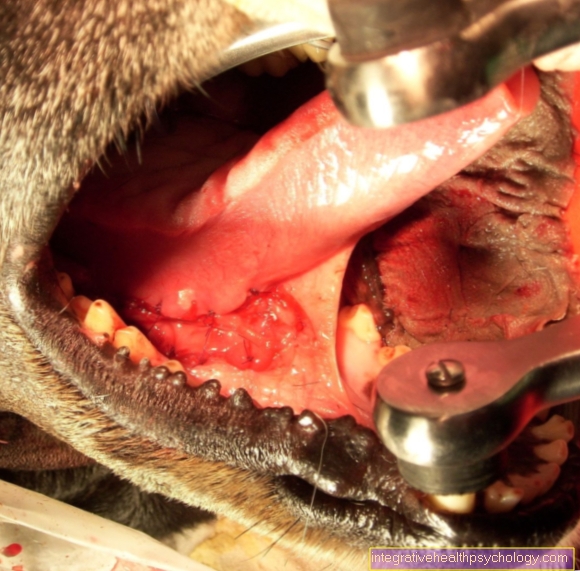The symptoms of scarlet fever
introduction
Scarlet fever is one of the typical childhood diseases and affects most people in the course of their lives. The disease is triggered by the bacteria streptococci.
The highly contagious disease is accompanied by purulent tonsillitis and skin rashes. Those affected usually feel very sick subjectively. There are some key symptoms, but the disease does not have to have all of the symptoms.
Antibiotic therapy is necessary for treatment, as this can prevent long-term effects.

Symptoms in the child
Scarlet fever is a childhood disease and particularly affects children of elementary school age.
The children have swollen, red throats and purulent specks on the tonsils. They complain of sore throats and headaches and are weaker than usual. The tongue is described as a raspberry tongue and a rash appears all over the body, which spares the palms and soles of the feet.
The children are very pale around the mouth and the cheeks are rather red. The children develop a high fever. At the end of the disease, the skin flakes.
A scarlet fever disease that has just been through is not a reason for excluding further scarlet fever infections.
Find out more about the topic here Scarlet fever.
Symptoms in adults
Basically, a scarlet fever disease in adults is similar to that in children. As with many childhood diseases, the course of scarlet fever is more complicated in adults.
The first symptom, in most cases, is the sore throat and specks of pus on the tonsils or in the tonsil cavities. The affected person develops a fever and the typical skin rash. The tongue also takes on a strong red color. The complications can be inflammation of the kidneys, heart, or joints.
You can also read the more detailed article on the clinical picture in adults at:
- Adult scarlet fever
Sore throat
In most cases, a sore throat is the first symptom of a scarlet fever infection and is an inevitable occurrence. The pain is caused by the swelling and inflammation of the throat and, if present, the tonsils.
The inflammation is usually purulent and the throat is noticeably reddened. The pus in the throat indicates that it is more of a bacterial infection rather than a virus, so it is an important indicator of scarlet fever.
A sore throat itself is a rather unspecific symptom and occurs with many diseases.
The difficulty swallowing
The difficulty swallowing in scarlet fever has two causes.
On the one hand, the throat is severely inflamed and the swallowing process is very painful for the person concerned. Often only liquid or soft food can be consumed.
Due to the swelling, however, the swallowing process itself is also disturbed and restricted even with pain medication. Ice or cold drinks can reduce the swelling in the throat, making it easier to swallow.
Particularly in children, care should be taken to ensure that they drink enough fluids, despite the difficulty swallowing.
The fever
Like most bacterial diseases, scarlet fever is associated with a fever. Body temperature rises rapidly at the onset of the disease. Basically, a fever is a normal response of the body to infection and shows that the immune system is fighting the disease. However, if the fever gets too high, it should be lowered with medication, as temperatures that are too high can impair body functions.
Like all symptoms, fever is not a necessary symptom of scarlet fever, which can make it difficult to diagnose. Without a fever, scarlet fever is often not recognized and can spread more easily.
The rash
Scarlet fever is one of the typical childhood diseases, which is particularly evident from the rash. The cause of the rash is a toxin produced by the bacteria that the skin reacts to. The rash usually doesn't start until a day or two after the first symptoms appear.
The rash consists of small spots that begin in the armpit and groin region. Later, the rash spreads all over the body, leaving the soles of the feet and palms exposed. There is also less redness and more pale skin around the mouth.
The rash is about the size of a pinhead, which is close together and rough to the touch. This is an important difference from chickenpox, which shows vesicles of different sizes.
The emphasis on the trunk of the body is different from rubella, which begins more on the face. So the rash is an important diagnostic criterion.
In contrast to other childhood diseases, the onset of the rash or its healing is not indicative of the risk of infection. After a few days the rash will heal and the skin will peel off in large lumps.
Read more about the topic here: Skin rash in scarlet fever.
The itching
A typical symptom of scarlet fever is a rough rash all over the body. This rash can cause severe itching. Itching can also occur as the symptoms subside.
Perfume-free skin care creams can relieve itching. Gloves can be put on small children to prevent the skin from being scratched. The itching subsides with the other symptoms of the disease.
What to do about a rash - You can find out more about this topic here.
The scarlet tongue
In many diseases, the tongue is a way of recognizing which pathogen is involved.
With scarlet fever, a thick, sweet-smelling coating forms over the entire tongue, which, however, quickly falls off. Then there is a distinct reddening of the tongue with individual swollen taste papillae. This coloring leads to the name strawberry or raspberry tongue, which is typical of scarlet fever.
If scarlet tongue occurs, community facilities such as kindergartens should be avoided and a pediatrician should be consulted.
These changes on the tongue are part of the rash and occur because the lining of the tongue tries to fight off the bacteria and their toxins. The scarlet tongue can be used to assess the severity of the disease.
Like many symptoms, the raspberry tongue is often part of the scarlet fever disease, but does not have to occur. The raspberry tongue may be missing, especially in the case of reinfections, i.e. when the disease flares up again. Just like the skin of the body, the tongue flakes off as the rash heals.
More information on the topic Scarlet tongue you'll find here.
The white tongue from the tongue coating
While the red raspberry tongue is relatively well known, most parents are not aware of the fact that there is a thick, white coating on the tongue at the onset of scarlet fever. This topping creates a sweetish bad breath.
After a short time the coating on the tongue falls off and the typical raspberry tongue forms. The white coating is a mixture of bacteria, food particles and mucus and collects on the tongue because of the weakened immune system.
However, a whitish coating on the tongue can also have causes other than scarlet fever. Another possibility would be a fungal disease.
Find out more about the topic here: Tongue coating.
The bad breath
One of the first symptoms of scarlet fever is a whitish coating on the tongue and specks of pus on the tonsils.These two symptoms lead to a sweetish halitosis and are important for the diagnosis of scarlet fever.
The bad breath cannot be eliminated by brushing your teeth. The pediatrician should be informed of this observation.
As the tonsillitis heals and the tongue coating falls off, the bad breath becomes weaker and disappears.
The tonsillitis
The tonsillitis is a major symptom in scarlet fever. The tonsils are red and swollen and there are sticks of pus on the tonsils. In those without tonsils, the pus specks appear in the almond cavities and the side cords are red. The swollen tonsils are the cause of the sore throat and difficulty swallowing.
The tonsils are part of the body's immune system and are therefore the first contact points with the pathogen, which is why tonsillitis is one of the first symptoms of scarlet fever.
Those affected can suckle ice to relieve pain, as this will reduce the swelling a little.
Find out more about the topic here: Tonsillitis.
The earache and the otitis media
The pharynx, which is severely inflamed in scarlet fever, is connected to the middle ear via the ear trumpet. Pathogens such as streptococci can migrate through this into the middle ear. If the body is weakened by disease, this can lead to inflammation in the ear.
Earache can occur with scarlet fever even without an otitis media. Some nerves that supply the throat and pharynx also carry fibers from the ear, which can send incorrect information to the brain.
Find out more about the here Otitis media symptoms.
The swelling of the lymph nodes on the neck
The lymph nodes are an important part of the body's defense system. In a healthy person, most of the lymph nodes cannot be palpated.
With a scarlet fever infection, the lymph nodes react to the bacteria and their toxins and more defense cells are formed, which is why the lymph nodes swell and become palpable.
Lymph nodes that swell due to a bacterial disease can be painful and can move in relation to their surroundings.
The lymph node swelling can usually be felt on both sides. As the disease heals, the lymph nodes swell again.
How dangerous is a swelling of the lymph nodes in the neck? - Read more here.
The stomach ache
People with scarlet fever often have a feeling of illness affecting the whole body and can also get abdominal pain as part of the illness. This can be caused by the disease itself or by the antibiotic, as these often have abdominal pain and diarrhea as side effects.
Small children in particular cannot yet describe exactly what symptoms they have and therefore often relate malaise to the stomach. In addition to stomach pain, vomiting and diarrhea can also occur.
The vomiting
With scarlet fever, the person affected is generally very weak and sick, which can be seen in all areas of the body. Nausea and vomiting can occur. Because people often do not eat a lot of solid food, they only vomit fluids.
In addition to the disease itself, therapy with the antibiotic or painkillers can lead to stomach pain and vomiting. Pain tablets like ibuprofen can make you feel sick, especially on an empty stomach.
The neck pain
Neck pain can have different causes. In the case of complete immobility, it is usually a question of tension or vertebral blockage, which can come about through lying incorrectly.
In the context of an infectious disease, however, neck pain must always be considered as the possibility of meningeal irritation or even meningitis. This is a serious complication of some bacterial diseases and is an emergency. People who are suspected of having meningitis should go to hospital quickly.
More information on the topic Meningitis you'll find here.
The joint inflammation
Joint inflammation in scarlet fever usually does not occur during the actual illness, but a few weeks later.
The body has built defense cells against the bacteria poison and remembers their structure. However, some of the body's own structures are very similar to the poison and can therefore be attacked by the immune system. This is called rheumatic fever.
In addition to the joints, the heart or brain can also be affected. These long-term effects can be prevented through timely antibiotic therapy.
The pneumonia
Pneumonia can be a complication of strep infection. While healthy children and adults rarely develop pneumonia, those with compromised immune systems can quickly acquire pneumonia.
Pneumonia, like uncomplicated scarlet fever, is treated with antibiotics. However, some courses may require hospitalization. Since pre-existing illnesses are particularly affected, very severe courses can occur.
Read more about the here possible Complications of scarlet fever.





























